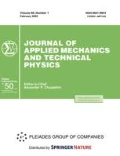Abstract
Chemical processes governed by the laws of diffusion kinetics can be intensified by elastic oscillations. It is also known that the rate of combustion of liquid and solid fuels changes markedly with the onset of acoustic vibrations in the combustion chamber. Despite the extensive application of vibrational processes in technology, the mechanisms of heat and mass transfer in the presence of vibrations are not well known. The aim of this research was to analyze the mass transfer from a sphere in an acoustic field.
Similar content being viewed by others
Abbreviations
- ω :
-
angular frequency of oscillations
- λ:
-
wavelength
- R:
-
characteristic dimension of axisymmetric body
- s:
-
amplitude of displacement of fluid particles in a plane acoustic wave
- B:
-
amplitude of oscillation velocity
- x, y:
-
longitudinal and transverse coordinates
- u, v:
-
longitudinal and transverse velocity components
- v :
-
kinematic viscosity
- U — A(x) cos ωt:
-
velocity of potential flow
- δ+ :
-
thickness of momentum boundary layer
- δ− :
-
thickness of diffusion boundary layer
- m:
-
dimensionless concentration
- m* :
-
concentration of diffusing component at surface of vaporization
- t:
-
time
- D:
-
diffusion coefficient
- ρ:
-
average density of mixture
- erf:
-
error function
- r:
-
radius of axisymmetric body
- R:
-
Reynolds number
- P:
-
diffusion Prandtl number
- 〈〉:
-
time average
- N, Nd :
-
Nusselt numbers based on radius and diameter respectively
- ′:
-
pulsating component of velocity or concentration
- o:
-
stationary component of velocity or concentration
References
A. M. Ginstling and A. A. Barom, Ultrasound in Chemical Engineering Processes, [in Russian], Goskhimizdat, 1960.
E. N. Andrade, “On the circulations caused by vibration of air in a tube.” Proc. Roy Soc. A, vol. 134, p. 363, 1931.
J. Holstmark, S. Johnsen, T. Sicceland and S. Skavlem, “Boundary layer flow near a cylindrical obstacle in an oscillating, incompressible fluid,” J. Acoust. Soc. America, vol. 27, p. 102, 1954.
H. Schlichting, Boundary Layer Theory [Russian translation], IL, 1956.
D. Roy, “Non-steady periodic boundary layer.” Z. angew. Math. und Phys., vol. 12, p. 363, 1961.
Lighthill, “The response of laminar skin friction and heat trnasfer to fluctuations in the stream velocity.” Proc., Roy. Soc. A, vol. 224, p. 1, 1954.
Collection: Physico-Chemical Properties of Individual Hydrocarbons, [in Russian], M. R. Timofeev, Goskhimizdat, 1953
Gililand, “Diffusion coefficients in gaseous streams.” Industr. and Engng Chem., vol. 26, 1934.
Reynst, “Pulsating combustion chambers.” Oil. Engine, vol. 20, No. 238, 1953.
R. Eckert and R. M. Drake, Heat and Mass Transfer [Russian translation], Gosenergoizdat, 1961.
Author information
Authors and Affiliations
Additional information
In conclusion, the authors wish to thank S. S. Kutateladze and I. A. Yavorskii, who supervised the present work.
Rights and permissions
About this article
Cite this article
Burdukov, A.P., Nakoryakov, V.E. On mass transfer in an acoustic field. J Appl Mech Tech Phys 6, 51–55 (1965). https://doi.org/10.1007/BF00915612
Issue Date:
DOI: https://doi.org/10.1007/BF00915612



